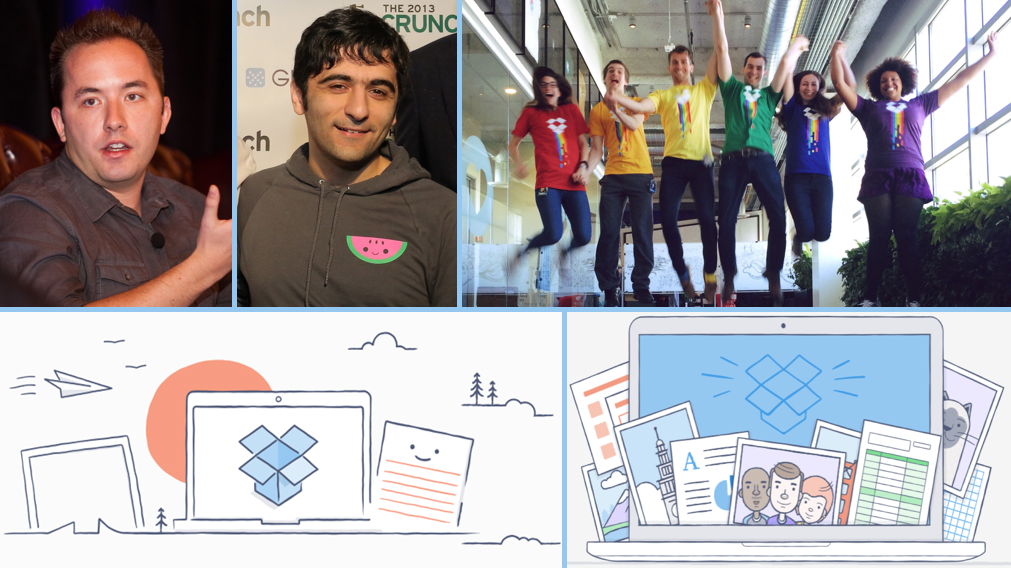
Unicorns 14/229 – Dropbox
DROPBOX
Founders: Drew Houston, Arash Ferdowsi
Number of employees: 1,200+
Dropbox is a file hosting service operated by American company Dropbox, Inc., headquartered in San Francisco, California, that offers cloud storage, file synchronization, personal cloud, and client software. Dropbox was founded in 2007, by MIT students Drew Houston and Arash Ferdowsi, as a startup company, with initial funding from seed accelerator Y Combinator.
Dropbox creates a special folder on the user’s computer, the contents of which are then synchronized to Dropbox’s servers and to other computers and devices that the user has installed Dropbox on, keeping the same files up-to-date on all devices. Dropbox uses a freemium business model, where users are offered a free account with a set storage size, with paid subscriptions available that offer more capacity and additional features. Dropbox Basic users are given 2 gigabytes of free storage space. Dropbox Plus users are given 1 terabyte of storage space, as well as additional features, including advanced sharing controls, remote wipe, and an optional Extended Version History add-on. Dropbox offers computer apps for Microsoft Windows, Apple macOS, and Linux computers, and mobile apps for iOS, Android, and Windows Phone smartphones and tablets. In March 2013, the company acquired Mailbox, a popular email app, and in April 2014, the company introduced Carousel, a photo and video gallery app. Both Mailbox and Carousel were shut down in December 2015, with key features from both apps implemented into the regular Dropbox service. In October 2015, it officially announced Dropbox Paper, its collaborative document editor, in a reported effort to expand its operations towards businesses. As of March 2016, Dropbox has 500 million users.
Dropbox has received praise, including the Crunchie Award in 2010 for Best Internet Application, and Macworld’s 2009 Editor’s Choice Award for Software. It has been ranked as one of the most valuable startups in the US and the world, with a valuation of over $10 billion, and it has been described as one of Y Combinator’s most successful investments to date. However, Dropbox has also experienced criticism and generated controversy for issues including security breaches and privacy concerns.
History
2008-09: Early development and launch
Dropbox founder Drew Houston conceived the Dropbox concept after repeatedly forgetting his USB flash drive while he was a student at MIT. In a 2009 “Meet the Team” post on the Dropbox blog, he wrote that existing services at the time “suffered problems with Internet latency, large files, bugs, or just made me think too much.” He began making something for his personal use, but then realized that it could benefit others with the same problems. Houston founded Dropbox, Inc. in June 2007, and shortly thereafter secured seed funding from Y Combinator. Dropbox officially launched at 2008’s TechCrunch Disrupt, an annual technology conference. Owing to trademark disputes between Proxy, Inc. and Evenflow (Dropbox’s parent company), Dropbox’s official domain name was “getdropbox.com” until October 2009, when it acquired its current domain, “dropbox.com”.
2010-present
In May 2011, Dropbox struck deals with mobile carrier Softbank and then-named phone maker Sony Ericsson, with terms of the deal including that Dropbox’s mobile app would come pre-installed on mobile phones in Asia and Europe. In an interview with TechCrunch’s “Founder Stories” in October 2011, Houston explained that a demo video was released during Dropbox’s early days, with one viewer being Arash Ferdowsi. Ferdowsi was “so impressed” that they formed a partnership. In regards to competition, Houston stated that “It is easy for me to explain the idea, it is actually really hard to do it.”
In April 2012, Dropbox announced an automatic photo uploading feature, allowing users to automatically upload photos or videos from cameras, tablets, SD cards, or smartphones to a dedicated “Camera Uploads” folder in their Dropbox. Users were given 500 megabytes of extra space for uploading their first photo, and would be given up to 3 gigabytes of extra space if users continued using the method for more photos. In September, Facebook and Dropbox integrated to allow users in Facebook Groups to share files using Dropbox. In December, Dropbox set up an office in Dublin, Ireland, its first office outside the United States.
In November 2013, Dropbox announced changes to “Dropbox for Business” that would enable users to connect both their personal Dropbox and their business Dropbox to the same device, with each of the folders being “properly labeled for personal or work, and come with its own password, contacts, settings, and files.” Furthermore, Dropbox announced shared audit logs, remote wipe for business administrators, and account transfers, as new features of its Business offering. The same month, Dropbox also released a new version of its iPhone and iPad mobile app, that updated it with a new “whiter, more minimalistic user interface” designed for iOS 7, along with support for AirDrop (for sharing links and files wirelessly with nearby iOS devices), and a full-screen/split-screen interface toggle for the iPad.
In April 2014, Dropbox introduced Carousel, a photo and video gallery that “combines the photos in your Dropbox with the photos on your phone, and automatically backs up new ones as you take them.” Carousel sorted photos by event and date. In July, Dropbox introduced “streaming sync” for its computer apps. Streaming sync was described as a new “supercharged” synchronization speed for large files that improves the upload or download time by up to 2 times. In September, the release of iOS 8, Apple’s new mobile operating system, created compatibility issues for Dropbox. The company announced that users had to update their apps to fix automatic photo uploads. However, this caused duplicate files of users’ photos. Dropbox explained that “duplicates are backed up versions of thumbnails generated by Apple’s iCloud My Photo Stream and are being recognized as unique images by Dropbox”, and wrote that users needed to disable either the iCloud photo sync or Dropbox/Carousel in order to stop the duplication issue. Later, Dropbox announced that it had updated its mobile apps to prevent the duplication. In November, Dropbox announced a partnership with Microsoft to integrate Dropbox and Microsoft Office applications on iOS, Android and the Office 365 applications on the web.
In April 2015, Dropbox launched a Dropbox Notes collaborative note-taking service in beta testing phase, prompting speculation if Dropbox was planning to bring out a product to compete with Google Docs. TechCrunch noted that Dropbox Notes appeared to be a new version of “Project Composer”, a previous iteration of the service with roots from the acquisition of Hackpad in April 2014. In August, Dropbox announced the availability of “Universal 2nd Factor” USB security keys, providing two-factor authentication for logging into its services.
In August 2016, Dropbox ceased support for computers running Windows XP. In a post on its help pages, Dropbox explains that all linked computers were signed out on August 29, 2016, and users would need to update to Windows Vista or a later version of Windows in order to use Dropbox again.
In January 2017, Dropbox introduced “Smart Sync” for Business and Enterprise customers, a feature that lets Windows and macOS users see all files in the Dropbox folder, but only download specific files on-demand. In March, Dropbox renamed Dropbox Pro, its paid plan, to Dropbox Plus. In a blog post, it noted that “Don’t worry—the name is the only change we’re making. You’ll still get the same space and advanced features at the same price.” In April, Dropbox redesigned its website interface, bringing simplified navigation with a new thumbnail view, separation of work and home files, and a revamped Admin Console for Dropbox Business administrators.

